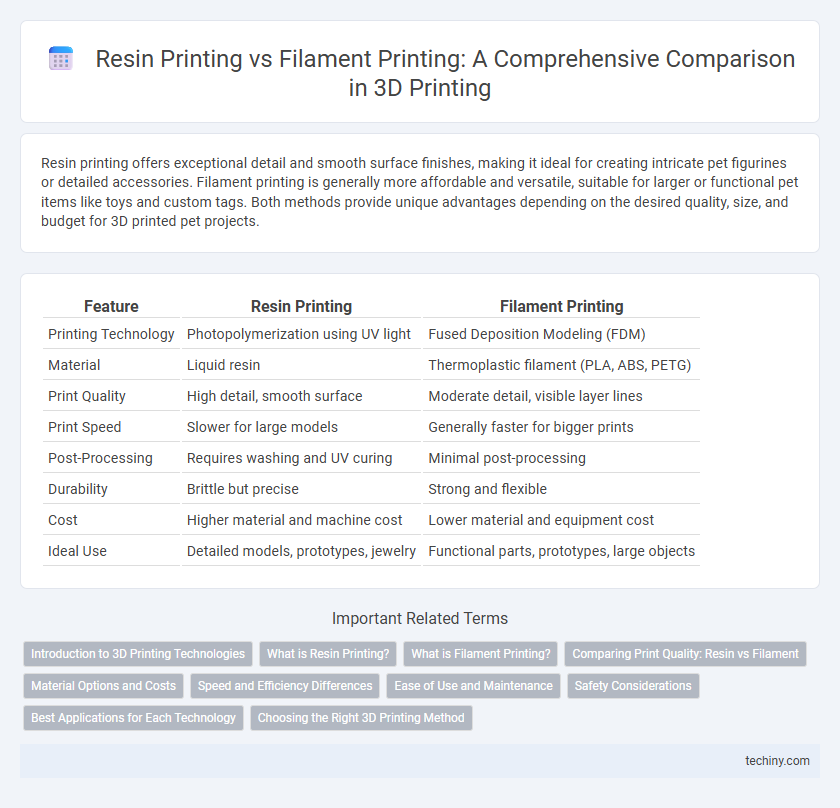Resin printing offers exceptional detail and smooth surface finishes, making it ideal for creating intricate pet figurines or detailed accessories. Filament printing is generally more affordable and versatile, suitable for larger or functional pet items like toys and custom tags. Both methods provide unique advantages depending on the desired quality, size, and budget for 3D printed pet projects.
Table of Comparison
| Feature | Resin Printing | Filament Printing |
|---|---|---|
| Printing Technology | Photopolymerization using UV light | Fused Deposition Modeling (FDM) |
| Material | Liquid resin | Thermoplastic filament (PLA, ABS, PETG) |
| Print Quality | High detail, smooth surface | Moderate detail, visible layer lines |
| Print Speed | Slower for large models | Generally faster for bigger prints |
| Post-Processing | Requires washing and UV curing | Minimal post-processing |
| Durability | Brittle but precise | Strong and flexible |
| Cost | Higher material and machine cost | Lower material and equipment cost |
| Ideal Use | Detailed models, prototypes, jewelry | Functional parts, prototypes, large objects |
Introduction to 3D Printing Technologies
Resin printing uses photopolymer resins cured by UV light to create high-resolution, detailed models, making it ideal for intricate designs and smooth surface finishes. Filament printing, also known as Fused Deposition Modeling (FDM), extrudes thermoplastic filaments layer-by-layer, offering durability and versatility for functional prototypes and larger objects. Both technologies serve distinct purposes in additive manufacturing, with resin excelling in precision and filament favored for strength and affordability.
What is Resin Printing?
Resin printing, also known as stereolithography (SLA) or digital light processing (DLP), uses a light source to cure liquid photopolymer resin layer by layer into precise, high-resolution 3D objects. This method excels in producing intricate details, smooth surfaces, and complex geometries, making it ideal for jewelry, dental models, and prototyping. Compared to filament printing, resin printing offers superior accuracy but requires post-processing steps like washing and curing to finalize the print.
What is Filament Printing?
Filament printing, also known as Fused Deposition Modeling (FDM), uses thermoplastic filaments heated and extruded through a nozzle to build objects layer by layer. Popular materials for filament printing include PLA, ABS, and PETG, offering versatility and strength for functional prototypes and end-use parts. This method is widely favored for its affordability, ease of use, and ability to create durable models with detailed structural integrity.
Comparing Print Quality: Resin vs Filament
Resin printing delivers higher resolution and finer details due to its liquid photopolymer curing process, making it ideal for intricate models and prototypes. Filament printing, using thermoplastic extrusion, generally produces lower resolution prints with visible layer lines but offers greater material variety and durability. The superior smoothness and precision of resin prints contrast with the robustness and cost-effectiveness of filament printing, influencing choice based on application needs.
Material Options and Costs
Resin printing offers high-detail and smooth surface finishes but typically involves higher material costs due to expensive photopolymer resins and the need for specialized cleaning supplies. Filament printing, using thermoplastic materials like PLA, ABS, and PETG, provides a wider range of affordable and readily available filaments suitable for diverse applications. Cost efficiency in filament printing makes it ideal for large-scale or functional parts, while resin printing excels in precision models despite higher material expenses.
Speed and Efficiency Differences
Resin printing offers higher resolution and intricate detail but typically involves slower printing speeds due to longer curing times per layer compared to filament printing. Filament printing (FDM) provides faster print speeds, making it more efficient for larger prototypes and functional parts where speed is prioritized over fine detail. Efficiency in filament printing is enhanced by quicker layer deposition and reduced post-processing, while resin printing demands additional curing and cleaning steps, impacting overall turnaround time.
Ease of Use and Maintenance
Resin printing offers high detail and smooth finishes but requires careful handling of liquid resin and regular cleaning of the vat and build plate, making maintenance more involved. Filament printing is generally easier to use for beginners, with straightforward loading and cleaning processes, though it often needs frequent nozzle unclogging and bed leveling. Both methods demand routine upkeep, but filament printers tend to have a simpler and less messy maintenance routine compared to resin printers.
Safety Considerations
Resin printing involves photopolymer resins that can emit harmful fumes and require careful handling with gloves and ventilation to prevent skin irritation and respiratory issues. Filament printing typically uses thermoplastic materials like PLA or ABS, which emit fewer toxic fumes but still need adequate ventilation due to potential release of ultrafine particles during heating. Proper safety measures include using enclosures, respirators, and maintaining workspace cleanliness to minimize exposure risks in both resin and filament 3D printing processes.
Best Applications for Each Technology
Resin printing excels in producing highly detailed, smooth-surfaced models ideal for jewelry, dental applications, and miniatures due to its superior resolution and fine layer accuracy. Filament printing, with its robust material options like PLA, ABS, and PETG, is better suited for creating larger, durable parts, functional prototypes, and mechanical components. Choosing between resin and filament printing depends on desired precision, surface finish, and material properties relevant to specific project requirements.
Choosing the Right 3D Printing Method
Resin printing delivers exceptional detail and smooth surface finishes, making it ideal for highly intricate models and prototypes, while filament printing offers greater material versatility and larger build volumes suitable for functional parts and prototypes. Evaluating project requirements such as resolution, mechanical properties, and cost efficiency is essential when choosing the right 3D printing method. Prioritize resin printing for precision-focused applications and filament printing for robust, scalable production needs.
Resin Printing vs Filament Printing Infographic

 techiny.com
techiny.com